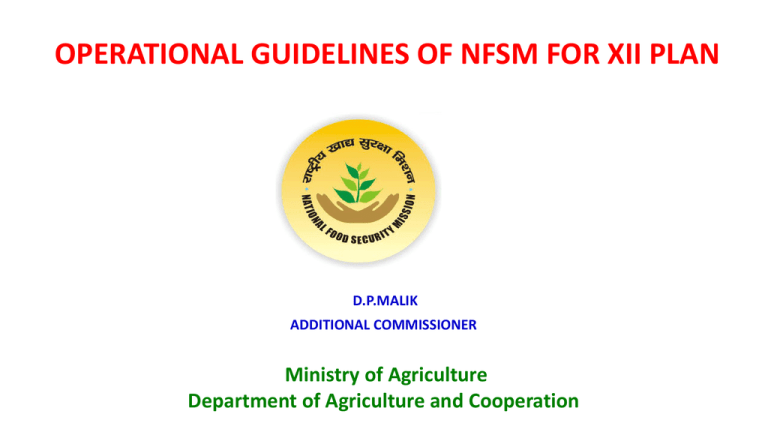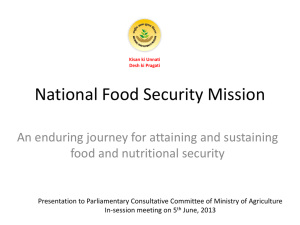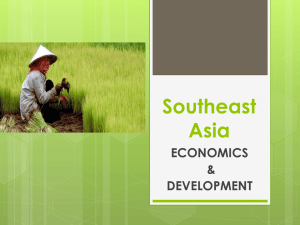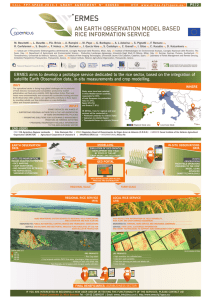Dr. D P Malik, Additional Commissioner (Crops)
advertisement

OPERATIONAL GUIDELINES OF NFSM FOR XII PLAN D.P.MALIK ADDITIONAL COMMISSIONER Ministry of Agriculture Department of Agriculture and Cooperation OBJECTIVES Ensure food and fodder security- area expansion and productivity enhancement of food crops including dual purpose coarse cereals. Restoration of soil fertility- micro-nutrients and soil ameliorants Enhancing farm level economy (i.e. farm profits)- postharvest, marketing support and value chain integration 2 National Food Security Mission PRODUCTION TARGETS DURING XI PLAN AND XII PLAN NFSM Component XI Plan XII Plan Wheat 08 08 Rice 10 10 Pulses 02 04 Coarse Cereals - 03 Total 20 25 Note : Coarse Cereals and commercial crops (Cotton , Jute, Sugarcane) included under NFSM during XII Plan 3 National Food Security Mission STRATEGIES • Low productivity and high potential areas , rainfed areas & remote areas • Cropping system approach rather than individual crop • Agro-climatic zone wise planning and cluster approach for crop productivity enhancement • Pulse production enhancement through utilization of rice fallow, rice bunds and intercropping of pulses with coarse cereals, oilseeds and commercial crops • Promotion and extension of improved technologies i.e., seed, INM, IPM, farm machineries , micro irrigation • Input use efficiency and resource conservation technologies • Post-harvest management ,value chain integration and marketing support to pulses & coarse cereals • Local/site specific initiatives • Capacity building of the farmers/extension functionaries 4 National Food Security Mission SCHEMES SUBSUMED WITH NFSM IN XII PLAN Name of Scheme/Programme Crops included under NFSM Initiative for Nutritional Security through Intensive Millets Promotion (INSIMP) Millets Integrated Scheme of Oilseeds, Pulses, Oil palm and Maize ( ISOPOM) Maize Accelerated Fodder Development Programme Dual purpose coarse cereals (AFDP) Technology Mission on Cotton (TMC) Cotton Jute Technology Mission (JTM) Jute 5 National Food Security Mission NFSM COVERAGE States Districts 30 27 24 25 557 469 500 23 20 400 16 16 15 10 600 300 9 11 200 5 100 0 0 Wheat Rice XI Plan Pulses Coarse Cereals XII Plan 199 141 119 Wheat 182 143 Rice XI Plan Pulses Coarse Cereals XII Plan 6 National Food Security Mission AREA OF OPERATION OF FOOD SECURITY MISSION XI Plan XII Plan Name of NFSM Component No. of States Covered No of Districts Covered No. of States Covered No of Districts Covered Wheat 09 141 11 119 Rice 19 143 24 199 Pulses 16 469 23 557 Coarse Cereals - - 27 182 Total 480 570 Millets are covered under INSIMP a sub scheme of RKVY during XI Plan NFSM-Wheat and NFSM-Rice Districts selected on the basis of having area more than 50,000 ha each and yield below State Average Yield. NFSM-pulses -all districts of states expect H.P., Uttarakhand, J&K and Kerala In case of coarse cereals, the districts covering 70 % of the total coarse cereals area of the State have been selected All districts of north-eastern states (except Assam) with at least 5000 ha area under rice have been selected. Districts with at least 15000 ha area under rice or wheat in hill states of Himachal Pradesh, Jammu & Kashmir and Uttarakhand have been selected. 7 National Food Security Mission DISTRICT COVERED UNDER NFSM DURING XII PLAN Sl No. States 1 Andhra Pradesh 2 Arunachal Pradesh 3 Assam 4 Bihar 5 Chhattisgarh 6 Gujarat 7 Haryana 8 Himachal Pradesh 9 Jammu & Kashmir 10 Jharkhand 11 Karnataka 12 Kerala 13 Madhya Pradesh 14 Maharashtra 15 Manipur Rice 09 10 13 15 12 02 02 08 04 07 01 08 08 09 Wheat 10 05 07 09 05 17 03 - National Food Security Mission Pulses 22 17 27 38 18 26 21 17 30 51 33 09 Coarse Cereals 08 07 04 11 05 08 05 05 07 11 11 01 16 08 02 8 Contt.. Sl. No. 16 17 18 19 20 21 22 23 24 25 26 27 States Meghalaya Mizoram Nagaland Odisha Punjab Rajasthan Sikkim Tamil Nadu Tripura Uttar Pradesh Uttarakhand West Bengal Total States Total Districts Rice Wheat Pulses Coarse Cereals 07 06 11 14 02 08 08 23 05 07 10 13 31 09 - 11 08 11 30 20 33 04 30 08 75 18 03 04 04 06 03 12 02 10 02 20 04 03 24 199 11 119 23 557 27 182 National Food Security Mission 9 CHANGES IN REVAMPED NFSM DURING XII PLAN NFSM IN 11TH PLAN NFSM IN 12TH PLAN Rice, wheat, pulses Rice, Wheat, pulses, Coarse Cereals Foodgrain security Food grain and fodder security-National Food Security Act. Focus on Low Productive Areas. Focus on Low Productive Areas, Problematic Areas, Rainfed Areas , Remote Areas NFSM- rice, wheat and Pulses NFSM-Rice. wheat and Pulses and Coarse cereals , Sub-mission on Cotton and Jute and Sugarcane Cropping system based approach Individual Crop Post harvest technologies not included Same technologies for all the areas included Value chain Integration marketing) not included of small producers Post harvest technologies like primary processing (destonning, grading, dehusking) and dal mill Low productive areas- demonstration of Intensive crop development technologies on cluster approach High productive areas- resource conservation technologies ( Value chain Integration of small producers ( marketing) included COMPOSITION OF NFSM STRUCTURE National Food Security Mission General Council (NFSMGC) National Level State Level District Level XI Plan Inclusion in XII Plan • • Chairman : Minister of Agriculture Member : Secretary (A&C) ,Secretary (DARE) &DG (ICAR), Secretary (Finance) , Adviser , Agriculture( Planning Commission) and Agriculture Commissioner . Member Secretary: Mission Director • Secretary (Food, Consumers Affairs &Public Distribution) , Secretary (Panchayati Raj), Secretary (Tribal Affairs), Secretary (Social Justice and Empowerment, Secretary ( Women & Child Development). Chairman : Secretary (A&C) Member :Secretary (DARE) &DG (ICAR), Secretary(Water Resources), Secretary(Fertilizers), Adviser, Agriculture (Planning Commission), Agriculture Commissioner and Five Experts. Member Secretary: Mission Director • Secretary (Panchayati Raj), Secretary (Tribal Affairs), Secretary (Social Justice and Empowerment, Secretary ( Women & Child Development). • National Food Security Mission Executive Committee (NFSMEC) • • State Food Security Mission Executive Committee (DFSMEC) • Chairman : Chief Secretary • Member : APC, Secretary (Agri.), Secretary (Irrigation), Secretary (Power), Vice Chancellor(s)of SAUs,Director/Project Director of ICAR Institutes and Representatives of Lead Bank) and • Member Secretary : State Mission Director • Member : Agriculture Production Commissioner, Secretary ( Panchayati Raj), Secretary (Tribal Affairs), Secretary (Social Welfare), Director (Agri.) , Representatives of NABARD and Lead Bank District Food Security Mission Executive Committee (DFSMEC) • • • • • Chairman : District Collector/CEO of Zilla Parishad Member : Representatives from line Departments, Nominated progressive farmers, Representatives from Self Help Groups of farmers, Representatives from reputed NGOs, Representative of KVK /ICAR/SAU , Project Director ATMA, Member Secretary : Deputy Director (Agriculture)/District Agriculture Officer National Food Security Mission Representative from Lead Bank & NABARD, 11 ROLE OF PANCHAYATI RAJ INSTITUTIONS Activity Involvement of Panchayati Raj Institutions in selection of beneficiary farmers Demonstrations of Improved Crop Technologies Village /Gram Panchayat Seed Distribution Village /Gram Panchayat Integrated Nutrients/ soil ameliorants Management Village /Gram Panchayat Plant Protection Measures Village /Gram Panchayat Farm Machineries and Implements Zilla Parishad CRITERIA FOR IDENTIFICATION OF AREAS AND BENEFICIARIES 16% - SCP-Scheduled Castes and 8% for TSP- Scheduled Tribes. Allocation to SC/ST farmers will be made proportionate to their population in the district. 33% allocation of the funds- small and marginal farmers. 30% allocation of the funds- women farmers. All the farmers are entitled to avail the assistance for various components of NFSM limited to 5 ha. in a season. ICAR, SAUs, KVKs, ATMA, reputed NGOs and other line departments-in planning and execution of demonstrations ICAR, SAUs and KVKs - technical support- formulation of district action plans, its implementation and monitoring. Technical staff will be sourced from ICAR/SAU/KVK for imparting training. PMT at the district level will help in developing synergy among research institutes and various line departments . 13 National Food Security Mission ACCELERATED CROP PRODUCTION PROGRAMME (ACPP) Large blocks of crop areas- cropping system based mode (30% ) as well as sole crops. Size of demonstration -100 ha for plain area and 10ha. for hill and north-eastern states Area -Lowest productivity areas in selected districts All farmers in a cluster would be included in a demonstration with at least 0.4 ha area for individual farmer. Selection of beneficiary Farmers-Gram Panchayat, contribution of resources, orientation meeting. Selection of Site- easily accessible , avoid on isolated field, representative of soil type and soil fertility status of the area. Soil Analysis- soil fertility status for use of fertilizer and soil ameliorants Identification of Technologies- productivity enhancement Development of package of inputs to be distributed- a package of inputs including micronutrients and bio-fertilizers . Distribution of demonstration kits and training of participating farmers- Orientation training programme for critical operations for the demonstrations and distribution of kits Monitoring- District PMT -demonstrations throughout the cropping season and report the outcome in prescribed format. Extension functionaries should visit the demonstration plots and arrange need based visits of scientists Display Board- No. of farmers , Village, Variety/ hybrid, type of demonstration, NPK Fertilizers, Bio-fertilizers ,micronutrient , Date of Sowing/Transplanting , Seed Rate and Spacing, other critical input s, Mobile number of PMT Variety /hybrid-More than one improved variety/hybrid in one cluster demonstration. Organization of Field day/kisan gosthi Reporting of the Results- compilation of results of the demonstrations at block/district/State level. At State level, the results of the demonstrations should be compiled in the form of document. Analyze the contribution of various interventions for up-scaling in succeeding years. Front Line Demonstrations – 5% of ACPP for FLDs of rice, wheat, pulses and coarse cereals by ICAR/SAUs/KVKs National Food Security Mission 14 CAFETERIA OF INTERVENTIONS FOR BLOCK DEMONSTRATION RICE • • • • • • • • • • HYVs-transplanted and direct seeded, SRI , Hybrids rice stress tolerant varieties Seed treatment Micro Nutrients : Zinc, Boron, Iron Bio-fertilizers Use of lime/liming material to correct soil acidity Use of Weedicides IPM in rice including mechanical devices Promotion of mechanical transplanting Moisture stress management chemicals like PPFM bacteria Green Manuring WHEAT • HYVs and rust tolerant HYVs • Lime and Liming Material for acidic soils • Gypsum/Phospho gypsum in moderately alkaline soils • Micro Nutrients : Zinc, Boron, Iron • Bio-fertilizers • Seed treatment with fungicide • Soil treatment for Termite control • Use of Laser land leveler • Line sowing using seed drills. • Weedicides • Moisture stress chemicals Potassium chloride or hydrogel • Green Manuring • Conservation agriculture PULSES • HVYS : Urd, Moong, Moth, Cowpea, Pigeon pea , Chick Pea, ield pea, Lentil, Horse gram • Seed treatment with ungicides/trichoderma • Intercropping of pulses with other crops like sugarcane, cotton etc • Promotion of summer moong • Planting of Pulses in rice fallows and rice bunds • Planting of Kharif Pulses on Ridges (Urd, Moong, Arhar) • Replacement of utera crop by sown crop • Use of Micro Nutrients Zinc, Boron , Iron , Molybdenum. • Bio-fertlizers :Rhyzobium and PSB, Potash mobilizing bacteria and zinc solubilizing bacteria • Use of Sulphur as a nutrient • Use of pre and post emergence weedicide • Demonstration on IPM including mechanical devices • Foliar spray of nutrients National Food Security Mission COARSE CEREALS Maize/Barely • Hybrid /HYVs • Seed treatment • Ridge furrow planting • Micro-nutrient: Zinc • Weedicide and Pesticide • Bio-fertilizers • Demonstration on IPM including mechanical devices Millets : • HYVs and hybrid : Pearl millet Sorghum and HYVs of small millets • line sowing • Micro nutrients (Zinc, Boron, Iron) • Weedicides and pesticides • Bio-fertilizers • Demonstration on IPM including mechanical devices 15 COST NORM FOR CLUSTER DEMONSTRATION & OTHER INTERVENTIONS Particulars Rice Wheat Pulses Coarse Cereals A. Demonstration (Rs/ha) 1. Individual Crop* 2. Cropping Based Approach 7500 12500 7500 12500 7500 12500 5000 - B. Seed Distribution** (Rs/ Kg) 1. High Yielding Varieties 2. Hybrid (Rice & Coarse Cereals) 10 50 10 - 25 - 15 50 C. Plant Protection (Rs /ha) 1. PP Chemicals & Bio-pesticides 2. Weedicides 500 500 500 500 500 500 500 500 D. Micro-nutrient & Soil Ameliorants (Rs / ha) 1. Gypsum /phospho-gypsum/ bentonite sulphur 2. Micronutrients 3. Bio-fertilizers (Rhizobium/ PSB) 4. Lime / liming materials 500 1000 750 500 - 750 500 100 1000 500 - E. Local initiatives 5% 5% 5% 5% *Cost norms for Field Day, distribution of publicity material and visit of scientists/GOI and state officials @Rs. 250, Rs. 250 and Rs. 300, respectively **20% of State’s Seed distribution of Hybrid/HYV to Central Seed Agencies like NSC/SFCI Reimbursement of subsidy for distribution of Hybrid/HYV seeds s will be made directly to agencies by the Ministry National Food Security Mission 16 FUNDS ALLOCATION UNDER NEED BASED INPUTS Particulars Share of allocation of funds(%) Remarks Seed distribution 49 Hybrid and HYVs IPM, INM, PP chemicals ,, bio-fertilizers and soil ameliorants 20 Weedicides, pesticides, biopesticides, Zinc, Boron , lime, Gypsum etc Farm machinery and implements 10 Machinery, implements and tools Water saving devices 20 Pump set, raingun, water carrying pipes , lining of ponds, sprinkler Training 01 famers COST NORMS FOR FARM MACHINERY & IMPLEMENTS Particulars Rs. per Unit Rice Conoweeder 600 √ Manual Sprayer: Knap sack sprayer/Foot 600 operated sprayer Drum Seeder in rice 1500 √ Power sprayer 3000 √ Chiseller (Deep Ploughing) 8000 Sprinkler set / Pump Set up to 10 HP 10000 Tractor Mounted Sprayer 10000 Wheat Pulses √ √ √ √ √ √ √ √ √ √ √ √ Coarse Cereals √ √ Seed Drill / Zero till seed drill / Multi crop 15000 Planter / Zero till multi crop Planter Ridge Furrow Planter 15000 √ Power weeder 15000 √ √ Water carrying pipes 15000 / 600 meter √ √ √ Mobile Rain gun 15000 √ √ Rotavator/turbo seeder 35000 √ √ √ Paddy Thresher/Multi crop thresher 40000 √ √ √ Laser Land Leveler 150000 / 10 farmers group √ √ √ Self Propelled Paddy Transplanter 75000 √ √ Zero Till Seed Drill and Sprinkler Set are not covered under NFSM-Rice 50% of the farmers under cluster demonstration will be selected for farm machineries and implements 18 National Food Security Mission PROJECT MANAGEMENT TEAM(PMT) • PMT –comprising of One consultant and Two Technical Assistants • 47 State PMTs and 441 District PMTs • State may engage one accountant in place of one TA at state headquarter • State may include District PMT under any of NFSM component i.e Rice, wheat, Pulses and Coarse cereals while preparing Action Plan • One state Level PMT –for each Crop Development Directorate COST NORMS OF TRAINING Item Rate (Rs.) Amount (Rs.) for 4 sessions of one training Honorarium for one trainer Rs.500/- per session Training material & stationary Rs.500/- per session Refreshment for trainees, Rs.50/- head per session for 35 persons supporting staff Contingency, POL transport ,etc. Rs.750/- per session Total 2000.00 2000.00 7000.00 3000.00 14000.00 Mission has adopted cropping system-based approach. Each training comprises of four (04) sessions focus on of each training. One at the beginning of kharif and rabi season, one each during kharif and rabi season. 30 participants/farmers in each session and participants in all four sessions will be same. Training will be imparted by crop/subject matter specialists of ICAR institutes/SAUs/KVK Training will focus on crop management (agronomic and plant protection practices) including primary processing of produce, storage etc. 20 National Food Security Mission STRATEGIC RESEARCH PROJECTS For address various research issues and yield gaps of food crops, research projects will be supported to ICAR/SAUs/International Organizations(ICARDA,IRRI,ICRISAT,CYMMIT etc.) Themes/area of research • • • • • • • • • • • . Conservation of natural resources (land, water) and their efficient use INM,IPM,IWM Modification/refinements in farm machines/tools for various soils types/cropping systems Up-scaling of improved crop varieties/hybrids in NFSM adopted states/agro-climatic zones under water/thermal stress conditions Nutrient management in problematic soil (acidic/alkaline/sodic) Crop-husbandry and Input use efficiency Rain-water management in kharif pulses Refinement of relay cropping systems and agronomic practices for intercropping systems involving pulses Quality seed storages in the humid and hot climatic conditions-coastal areas Value addition in case of coarse cereals and pulses Precision farming -nutrient manager and crop manager New Initiative included in Revised NFSM Specialized projects for high productivity areas Area to be covered Activities to be covered Reclamation of problematic soils surveys and project preparation Land development activities Application of amendments (gypsum, phospho-gypsum, pyrites etc) Reclamation package of crops tolerant to alkalinity/salinity/acidity etc. adapting the reclamation packages etc Development of water-logged areas Surveys for the project preparation Construction of field/community ditches linking to natural drains or pumping of the excess water to a natural drainage lines and related activities Evaluation of crops tolerant to water-logging etc. Projects to combat the effect of climate change: Demonstration of heat tolerant varieties Promotion of micro-irrigation system (drip and sprinkler) for protective irrigation etc. Cost norms (Rs.) Rs.50,000 per hectare with 25% share of farmer Each project proposal should not exceed Rs10 crores 22 National Food Security Mission DEMONSTRATIONS OF CROP PRODUCTION TECHNOLOGIES IN REMOTE AREAS AND ASSISTANCE FOR FARM MECHANIZATION Area to be focused Purpose Implementing agencies Cost norms Remarks Mostly rainfed and inhabited by tribal and poor farmers Cluster demonstrations of crops institutes/organizati ons/ NGOs As applicable to State/district states authorities will 10% of cost of monitor the work demonstration as done. institutional charge Implementing agencies will be identified at district level with criteria At least 3 years experience of successful execution of agriculture/rural development projects in remote/backward areas. Should have accounts audited for all programmes implemented during past three years. Assistance to Custom Hiring Centres Small land holders Accessibility to farm machines and implements for various farm operations Custom hiring centers Rs 1500 per hectare community operations of selected farm activities to be undertaken within a time frame VALUE CHAIN INTEGRATION OF SMALL PRODUCERS Forming and strengthening of Farmer Producer Organizations (FPOs) may offer collective strength Seed production and seed procurement Access to credit and improved technologies Reduction in transaction costs Facilitation value addition, Tapping high value markets States will be required to submit their action plans for FPO promotion, to be undertaken through SFAC or similar organizations Assistance for FPO promotion will be available for a maximum period of three years as per the FPO Process Guidelines of DAC. Action Plans must specify the commodity, target area and target producers and should be broadly divided into four areas (i) Mobilization, training, exposure and capacity building interventions (ii) Agriculture based livelihood interventions such as trial and demonstration of Good Agriculture Practices (replacement of varieties, pre-and Post-sowing practices, seed production and dissemination, INM, IPM, etc.) (iii) Formation and development of Kissan Producer Company or other institutional form (iv) linkage to value chain (marketing) SFAC will assist the States in drawing up action plans States will also have the flexibility to undertake FPO promotion through any other Central, State, civil society or private MARKETING SUPPORT FOR PULSES AND MILLETS Crops covered Activities to be covered Incentive to Implementing agencies Cost norms Pulses Establishment of Dal mills Farmer Farmers group Registered FPO SFAC Rs. 10.00 lakhs, or Similar organizations at 30% of the total cost, Centre/State level whichever is lower, as one time support Pulses and millets Branding and marketing of milled pulses or millets Registered FPO SFAC @Rs.5.00 lakh per FPO, Similar organizations at for one time support Centre/State level only Pulses and millets Marketing support (local) un-registered farmer groups SHGs SHG federation SFAC Rs.2.00 lakh per group Similar organizations at of 15 farmers for one Centre/State level time support only Pulses and millets set up and equip procurement centres to grade and processing Registered FPOs SFAC Rs.5.00 lakh per FPO Similar organizations at for one time support Centre/State level only LOCAL INITIATIVES To support important location specific interventions, which not covered under the normal activities of the Mission Activities like augmentation of water resources, development of godowns for safe storage of critical inputs, machines for post-harvest processing like graders, dehusking machines etc . Assistance will be limited to 5% of the total budgetary allocation Assistance would be limited to 50% of the cost of each intervention Interventions proposed would be evaluated by a team of experts at the State level and will be cleared by SFSMEC for releasing the funds to the implementing agency at the district level. 26 National Food Security Mission TRAINING AND AWARDS • Training of extension functionaries • • Central and State functionaries-latest crop specific technologies Involvement of SAUs, National and International research organizations- within country • Exposure visit/training of state technical officials • Enrichment of knowledge base of state technical officials • International organizations like IRRI, CYMMIT, ICRISAT, AVRDC, ICARDA or any other research organization in crop production technologies etc. would be organized. • Awards • Best Performing District award • 4 components of NFSM at interval of 2 years (one award per 5 NFSM districts for each crop)Rs.5.00 lakh • criteria for selection of district( NFSM guidelines) • National Award for Best Performing States • • 3 Awards to States for highest food production –Rs 2. crores 4 Awards – one each for the highest production under rice, wheat, pulses and coarse cereals –Rs1.0 crores • Leadership awards • District Level Officers for good performance in the field. MONITORING MECHANISM • District Level- DFSMEC and Project Management Team. • State Level- Committee to be constituted under the Chairmanship of the State Mission Director with members from the line departments, SAUs, Lead Bank, NABARD, ICAR institutes and Crop Development Directorates of DAC. • National Level-Committee to be constituted under the Chairmanship of the Mission Director with members from DAC, ICAR, SAUs, CDDs, research institutions concerned and officials of State Departments concerned. • Crop Development Directorates: The nine Crop Development Directorates will be involved in monitoring of the Mission activities in States assigned to them. • NLMOTs – Team constituted with involvement of Director, CDD for each state for monitoring the activities of the Mission. • • Close monitoring of physical and financial targets of various program interventions would be done by the monitoring teams. Format for monitoring these interventions would be prescribed by NFSMEC. SDES will be involved in adopting the prescribed format for data collection pertaining to different parameters of the Mission for monitoring to suit the local requirements. 28 National Food Security Mission EVALUATION OF NFSM • Baseline Survey- SDA/ SDES will do baseline survey know the resource endowments of the farmers and the level of crop productivity. • Concurrent Evaluation SDA/SDES/SAU will do evaluation every year to assess the performance of the Mission commensurate with annual action plan and its objectives. • Mid-term Evaluation: at national level through an independent agency/organization in 3rd year. • Impact Evaluation Study/Studies: at the National Level will also be undertaken through an independent agency after the third year of implementation. • Information communication technology (ICT)- Specialized software for the reporting, monitoring and evaluation of the Mission's activities. 29 National Food Security Mission MECHANISM OF FUND FLOW • Funds be directly released to State Governments • State Government would release funds to State Level Agency (SLA) . • SLA - District Level Agency in accordance with approved programme of the district. • Funds would be released in installments based on the progress reports and submission of utilization certificate. • Funds for the implementation of the activities of the components will be released by the SLA/DLA to the nodal departments for the procurement of the required inputs. • ‘Electronic Banking’ will be used for transfer of funds to the State Level Agency and further to the districts. • STA will have to maintain a separate budget and prescribed accounting system for the Mission, both at the State and district level. 30 National Food Security Mission REPORTING SYSTEM Quarterly Progress Reports (QPRs) by the 15th of the month following each quarter (e.g. April to June to be submitted by 15th July) Detailed Annual Progress Report (APR) within three (03)months after the end of the year (e.g. APR up to June of succeeding year) One copy of QPR/APR NFSM-Rice to DRD, Patna NFSM-Wheat to DWD, Ghaziabad NFSM-Pulses to DPD, Bhopal NFSM-Coarse cereals to DMD, Jaipur. Note: Formats for reporting in NFSM Guidelines 31 National Food Security Mission BASIC QUALIFICATION, EXPERIENCE AND HONORARIUM OF PMT Particulars A. District level: Consultants Educational Qualification & experience Technical Assistants Honorarium (Rs./ Month) Conveyance Allowance (Rs./ Month) Daily Allowance (Rs./Day) Basic degree in Agriculture with Masters Degree in Agronomy/Agri. Extension/Soil Science/Plant Protection/Crop Improvement having at least 10 years of field experience in crop production/ Extension. The person should have the ability of team leadership & motivation. Basic degree in agriculture with computer skills. In case of non-availability of agriculture graduates, candidates with basic degree in life sciences Person with experience of research and extension will be given preference. 30,000 1,000 150 (10 days in a month) Or as per state rules 20,000 800 100 (10 days in a month) Or as per state rules Doctorate Degree in Agronomy/ Agriculture Extension/Soil Science/Plant Breeding/Plant Protection /Crop Improvement having at least 10 years of field experience in crop production. Ability to analyze data and preparation of projects, writing reports/seminar notes/ articles as evidenced by publication in national/ international journals. The person should have the ability of team leadership & motivation. 50,000 2,000 200 (10 days in a month) Or as per state rules Master degree in Agriculture with specialization in management of field crops. Knowledge of computer essential. 2. Person with experience of research and extension will be given preference. 25,000 1,500 150 (10 days in a month) Or as per state rules B. State Level Consultants Technical Assistants Thank You for Your Patience





